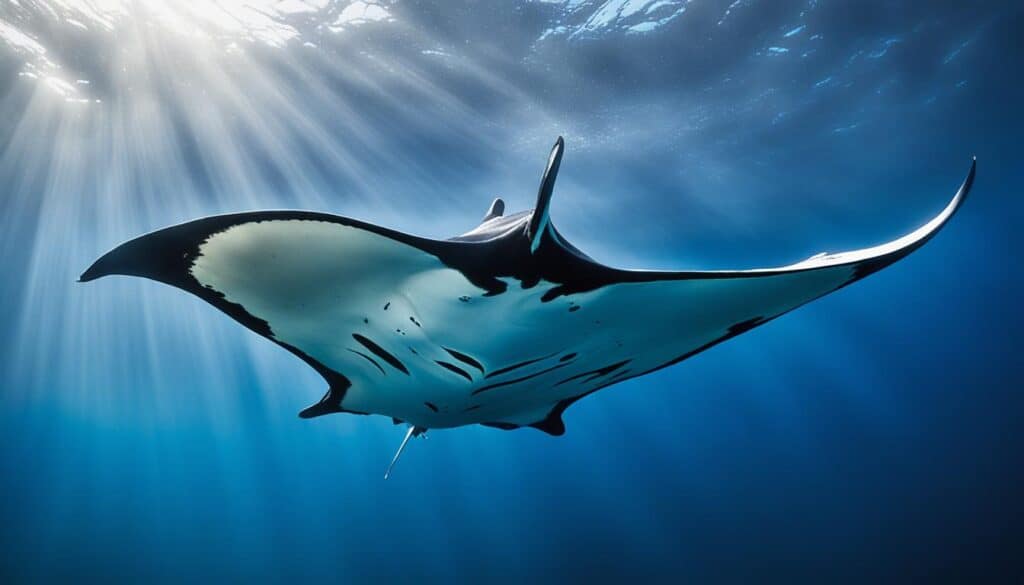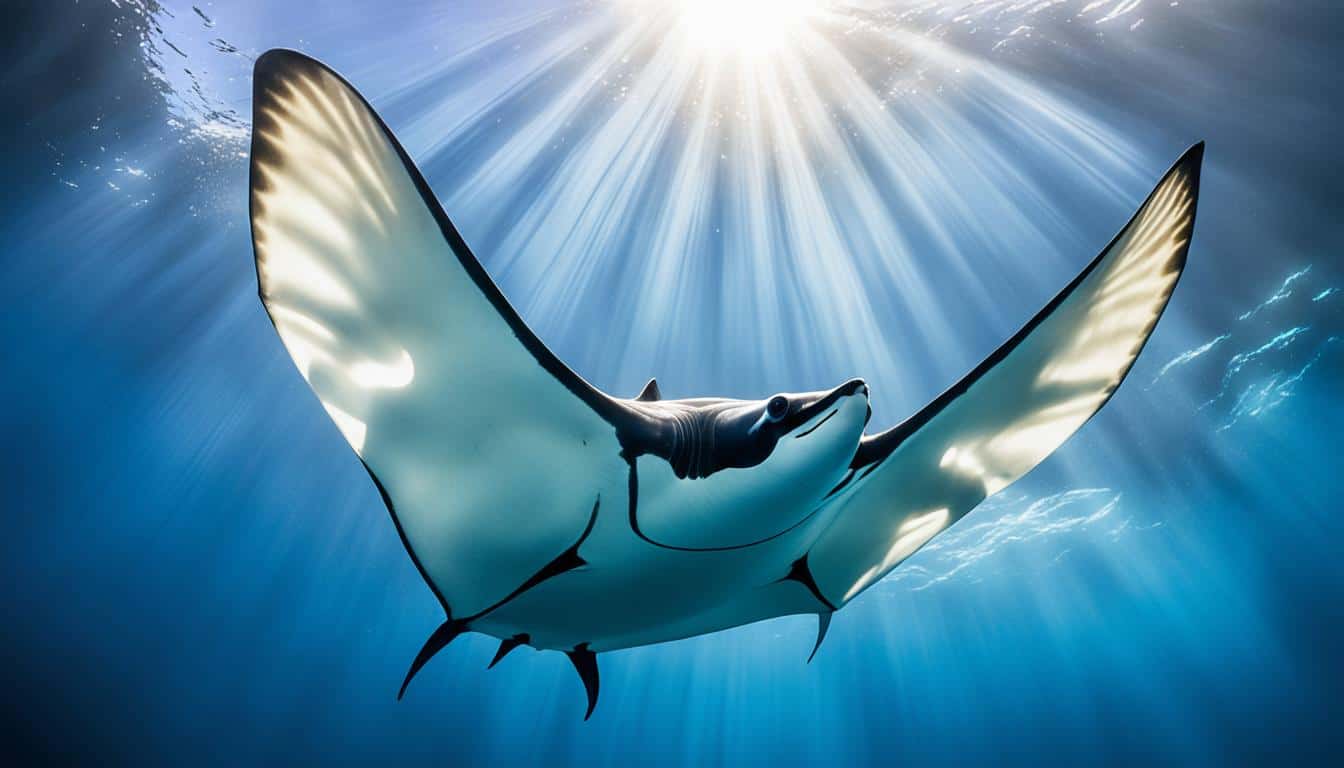Manta rays are fascinating creatures known for their graceful swimming abilities. You might ask, how do they swim? By looking at their anatomy and swimming techniques, we learn about their elegant movements. They use their large pectoral fins to move through the water with ease.
This article will explore the details of how manta rays swim. We’ll look at the biology behind their swimming. This helps us understand how these beautiful sea creatures live in the ocean.
The Anatomy of Manta Rays
The anatomy of manta rays is key to their amazing swimming skills. Their body structure helps them move and live in the water.
Structure of Pectoral Fins
Manta rays have big, triangular pectoral fins that can reach up to 22 feet long. These fins are vital for lift and movement. They make swimming easier and help them move through the water with less drag.
Body Shape and Size
Their bodies are flat and diamond-shaped, which helps them move smoothly. This shape lets them glide through the water with ease. Some manta rays can even weigh as much as 3,000 pounds.
Muscle Composition
Manta rays have muscles made just for swimming. These muscles help them move their fins and swim efficiently. This helps them survive in different parts of the ocean.
| Feature | Description |
|---|---|
| Pectoral Fin Span | Up to 22 feet for giant mantas |
| Body Shape | Flattened, diamond-like formation |
| Weight | Up to 3,000 pounds in certain species |
| Muscle Type | Specialized for efficient swimming |
Manta Ray Swimming Technique
Manta rays have a unique way of swimming that lets them move through the water with ease. They use a mix of movement styles, like oscillation and undulation. These methods help them move forward with grace and efficiency.
Oscillation vs. Undulation
Oscillation and undulation are the main ways manta rays move. Oscillation means they flap their big pectoral fins up and down. This action pushes them forward quickly.
Undulation, on the other hand, is a wave-like movement of their body and fins. It helps them move smoothly through the water. Both methods are important for their swimming efficiency. They let manta rays change speed and adapt to different situations.
Creating Vortices for Propulsion
When manta rays swim, they make vortices with their fins. These vortices help them move forward by adding thrust and cutting down on drag. The way they use oscillation and undulation helps them use the water to their advantage.
This knowledge helps scientists understand how manta rays stay agile and navigate their underwater world.
| Technique | Description | Benefits |
|---|---|---|
| Oscillation | Flapping pectoral fins up and down | Quick thrust; effective for short bursts of speed |
| Undulation | Wave-like motion along the body and fins | Smooth movement; enhances energy efficiency |
How do manta rays swim?
Manta rays swim in a unique way, using a special flapping motion. This motion and other factors affect their speed. They have special adaptations that help them move through the water well.
Understanding Flapping Motion
Their swimming motion combines oscillation and undulation. They move their pectoral fins in a rhythm. This creates a system that makes water flow over their bodies. This way, they use less energy to swim long distances.
Factors Affecting Swimming Speed
Several things can change how fast manta rays swim. Important factors include:
- Water Temperature: Warmer water makes them swim faster because it boosts their metabolism.
- Currents: Strong currents slow them down and make swimming harder.
- Physical Exertion: How hard they swim affects their speed too.
Knowing these factors helps us understand how manta rays adapt and succeed in different water environments.
Manta Ray Locomotion Patterns
Manta rays are amazing creatures with unique ways of moving. They swim with elegance and efficiency, especially when they’re just going about their day or hunting for food. By studying how they move, we can learn more about their life in the ocean.
Everyday Swimming Behavior
Manta rays swim through the water with grace. They use a special way of moving that saves energy. Their wide arcs make their swimming slow and smooth, letting them cover a lot of ground.
This way, they can find food and stay safe without using too much energy. It’s a smart way for them to move around the ocean.
Feeding Movements and Twirls
When it’s time to eat, manta rays use special moves to catch their food. They twirl in the water to bring plankton towards their mouths. This helps them get the most out of their meals.
They swim slowly and use their fins in a special way to guide the water full of food towards their mouths. This shows how well they’ve adapted to their ocean home.

| Behavior Type | Characteristics | Purpose |
|---|---|---|
| Everyday Swimming | Graceful, wide arcs | Energy conservation, exploration |
| Feeding Movements | Twirling, cephalic fin usage | Efficient food intake |
Swimming Speed of Manta Rays
Manta rays show off amazing swimming skills. They are both agile and powerful in the water. Their speed is key to their survival and helps them move through the ocean well.
Average Swimming Speed
On average, manta rays swim about 9 miles per hour. This speed lets them glide through the ocean smoothly. They look for food and stay safe while swimming. Their bodies are built for speed, thanks to their streamlined shape and strong fins.
Maximum Speed and Evasion Techniques
But manta rays can go much faster, up to 22 miles per hour in short bursts. These quick sprints help them get away from predators. They can change speed and direction fast, showing off their smart swimming skills.
| Swimming Speed | Type |
|---|---|
| 9 miles per hour | Average swimming speed |
| 22 miles per hour | Maximum burst speed |
Environmental Adaptations of Manta Rays
Manta rays have amazing ways to move through the water. They use manta ray fluid dynamics to swim better. This helps them survive in different ocean places. By changing how they use their bodies and fins, they make water vortices. These vortices help them swim faster and use less energy.
Utilizing Fluid Dynamics
Manta rays use fluid dynamics to move smoothly. When they flap their big fins, they make patterns in the water. This makes swimming easier and saves energy. It’s key for finding food and places to breed.
Energy Conservation Strategies
Manta rays also save energy in other ways. They swim slowly to cover more ground without getting tired. This way, they stay ready for dangers or to find food. Their skills make them strong in the ocean, showing how important they are to their homes.
FAQ
How do manta rays swim?
Manta rays swim by moving their big pectoral fins up and down. They also make a wave-like motion with their fins. This helps them move through the water smoothly.
What is the role of the anatomy of manta rays in their swimming?
Manta rays’ anatomy is key to their swimming. Their big triangular fins and flat, diamond-shaped body help them move. These features make it easier for them to swim through the ocean.
What are the key components of manta ray propulsion?
Manta rays move forward by flapping their fins. This creates vortices that push them forward. This special way of moving helps them swim well in different conditions.
How do environmental factors influence manta ray swimming speed?
Things like water temperature, currents, and how hard they’re working affect how fast manta rays swim. They usually go about 9 miles per hour. But, they can go up to 22 miles per hour to get away from predators.
What are the typical locomotion patterns of manta rays?
Manta rays swim in a beautiful way, often making wide arcs to save energy. When they’re eating, they use special twirls to catch plankton.
How fast do manta rays swim when evading predators?
When manta rays are trying to get away from predators, they can go as fast as 22 miles per hour. This shows how well they can swim and adapt in the wild.
What environmental adaptations do manta rays have to enhance their swimming abilities?
Manta rays have special ways to reduce drag in the water and save energy. They use slow gliding movements to cover long distances efficiently.







